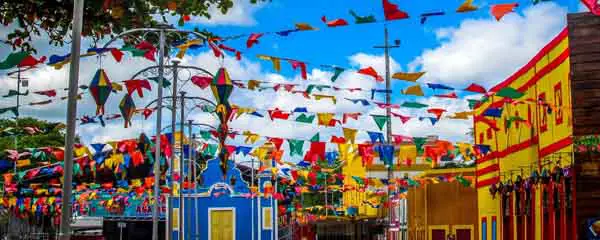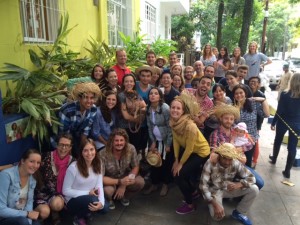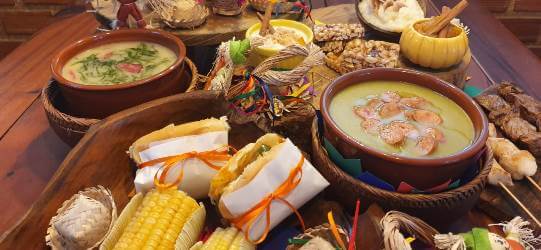Blog
Festa Junina in Brazil – Traditional Church Fairs: Vocabulary & Facts
- Thursday June 20th, 2024
- Posted by: Amanda Ennes
- Category: Brazil Learn the Portuguese Language and Portuguese Grammar

Festa Junina is a traditional celebration that occurs in June, during the wintertime in Brazil. It is a big part of the Brazilian culture, which celebrates the harvest season and also the Saints of June. Festa Junina in Brazil is also known for its traditional clothes, colors, decorations, games, and, of course, the food!
Even though most Brazilians celebrate Festa Junina nowadays, it is mostly a Catholic party. Church fairs followed by masses are organized to celebrate Saint Antony on June 13th, Saint John the Baptist on June 24th, and Saint Peter on June 29th.
Table of Contents
ToggleHistory of Festa Junina in Brazil
 Feasts like the Brazilian Festa Junina have existed in Europe since pre-Gregorian times. Over there, farmers celebrated fertile land and good harvests on the summer solstice.
Feasts like the Brazilian Festa Junina have existed in Europe since pre-Gregorian times. Over there, farmers celebrated fertile land and good harvests on the summer solstice.
Coincidentally, the indigenous people who inhabited Brazil before the arrival of the Portuguese also used to perform rituals in the month of June. These rituals would involve singing, dances, and a lot of food.
After the arrival of the Portuguese Jesuits, the two traditions merged. What we see in Festa Junina in Brazil today is a big mix of the two celebrations. Thus, having a great festivity full of typical dances and songs, a bonfire, country clothing, games, and food.
Traditions: Clothes, Food, Games, and Decoration
Even though we celebrate Festa Junina all around Brazil, this party is traditionally from the North and Northeast regions of Brazil. Festa Junina is also called São João, or Feast of Saint John. The São João party in Campina Grande, a city in the state of Paraíba, is the biggest Festa Junina in the world. It lasts the whole 30 days of the month of June.
Because of its origins honoring rural life, people started to wear traditional rural clothing for the party. People typically wear plaid shirts, floral dresses, straw hats, and country boots during the Festa Junina season. Furthermore, country dances and songs were also used to celebrate it.
A traditional Festa Junina is decorated with bonfires, colorful bunting flags, flowers, chintz fabric, and straw hats. Moreover, the food served at this party also honors the harvest season. The traditional Festa Junina food is mainly made of grains and roots the indigenous people in Brazil used to harvest this time of the year. So, dishes and desserts made from corn, peanuts, sweet potatoes, and cassava are the most popular ones.
A mock wedding followed by a traditional square dance, called quadrilha, is the most significant activity of Festa Junina. However, this kind of party also features different games for children and adults, such as big mouth toss, greasy pole, and fishing.
Vocabulary: Festa Junina in Brazil
General Vocabulary
- Quermesse: the church fair with food, games, and decorations, followed by a mass celebrating Saints Anthony, Peter, and John the Baptist.
- Arraiá: Festa Junina organized parties can also be called Arraiá or Arraial.
Festa Junina Food
If you want to learn more about the traditional food we eat during Festa Junina in Brazil, check our blog post Traditional Festa Junina Food in Brazil. This post is complete with information about the food and drinks found at church fairs all around Brazil.
Here is the most traditional food:
- Aipim e batata doce com melado: steamed cassava and sweet potato with molasses
- Amendoim: peanuts
- Arroz-doce: rice pudding
- Bolo de fubá: cornmeal cake
- Caldo verde: Portuguese green soup
- Canjica: hominy pudding
- Cocada: coconut candy
- Curau: corn pudding
- Cuscuz de tapioca: tapioca couscous
- Doce de abóbora: pumpkin compote
- Maçã do amor: candy apple
- Milho cozido: corn on the cob
- Paçoca: peanut candy
- Pamonha: sweet corn mush
- Pé-de-moleque: peanut brittle
- Pipoca: Popcorn
- Quentão: cachaça grog
- Quindim: coconut egg custard
- Salsichão: sausage
- Vinho quente: mulled wine
Decorations and Clothes
- Balão de papel: paper lanterns
- Bandeirinhas: bunting flags
- Bota: boots
- Camisa xadrez: plaid shirt
- Caipira: this is what traditional Festa Junina clothes are called, especially the dresses
- Chapéu de palha: straw hat
- Maria chiquinha: pigtail
- Fogueira: bonfire
- Trança: braid
Games
- Barraca do beijo: kissing booth
- Boca do palhaço: big mouth toss game
- Cabo de guerra: tug of war
- Casamento caipira: mock rural wedding
- Correio do amor or correio elegrante: an anonymous love mail sent throughout the party
- Corrida do ovo na colher: egg-and-spoon race
- Corrida do saco: sack race
- Dança da laranja: two people must dance balancing an orange with their foreheads without dropping it
- Jogo de argolas: ring toss game
- Pau de sebo: greasy pole
- Pescaria: fishing game
- Quadrinha: square dance
- Rabo do burro: pin the tail on the donkey game
- Tomba lata: can knockdown
Caminhos Language Centre is the largest and most exciting Portuguese school in Rio de Janeiro, Brazil. We have an excellent infrastructure, over 15 experienced Brazilian teachers, and a friendly multilingual support staff. We are the only school in Brazil able to offer Portuguese group courses throughout the year on 10 different levels. Moreover, our school also offers more than just Portuguese lessons for foreigners, we offer you the complete Rio de Janeiro experience. Every day we organize 100% free and fun activities for you to socialize and practice your Portuguese. We can also help you with a student visa for Brazil and accommodation in Rio de Janeiro. Follow us on Instagram for some Portuguese tips and news.


 Deutsch
Deutsch Français
Français Português
Português Español
Español


puede ser mejor pero nadie me toma encerio por mi nombre peor melele pancha digo buen texto
So capa de desert
Otimo texto Parabens Obrigado pela ajuda 🙂
Junio tiene 30 días
Amamos a la profe de portugués, pero su clase es aburrida :C